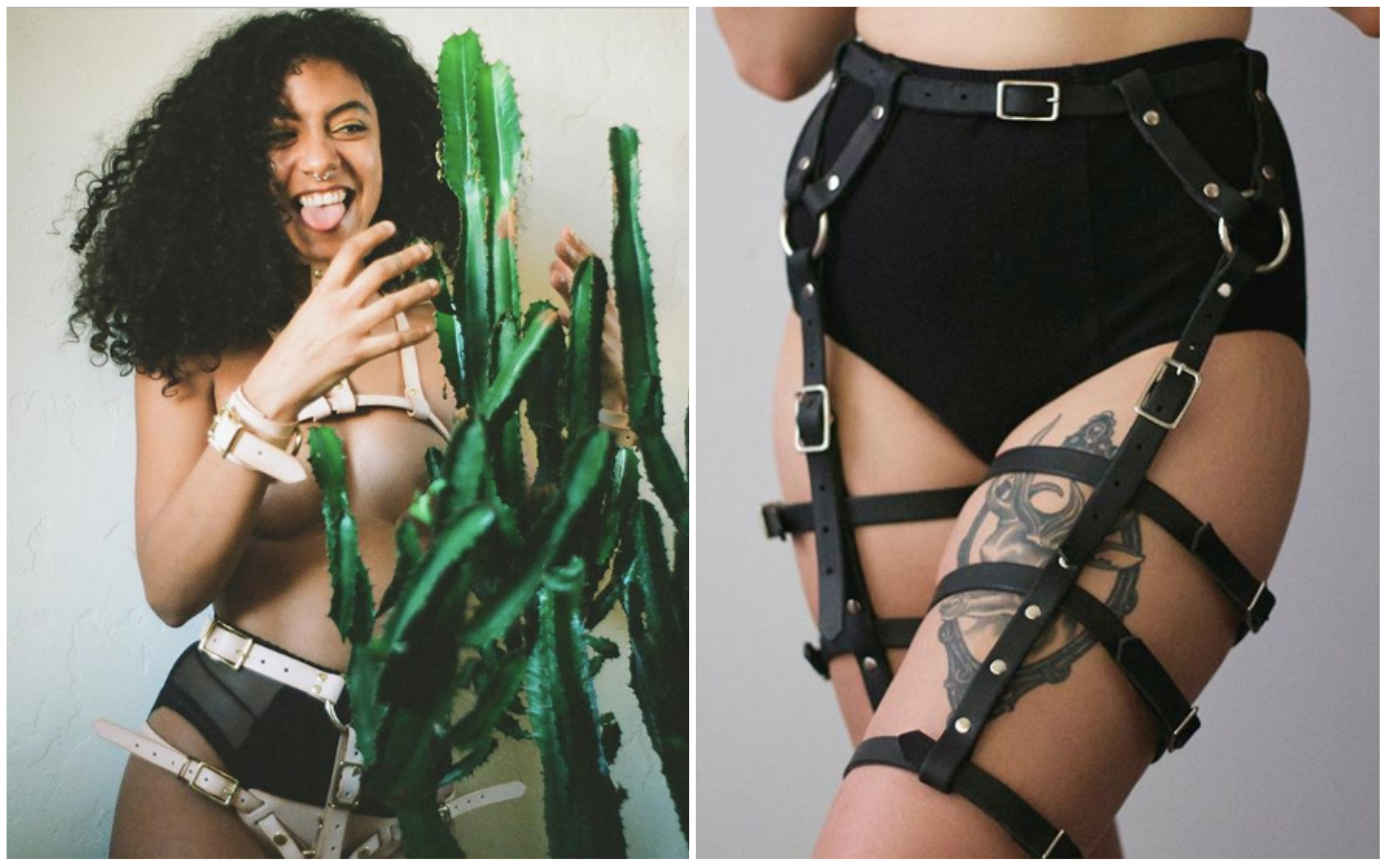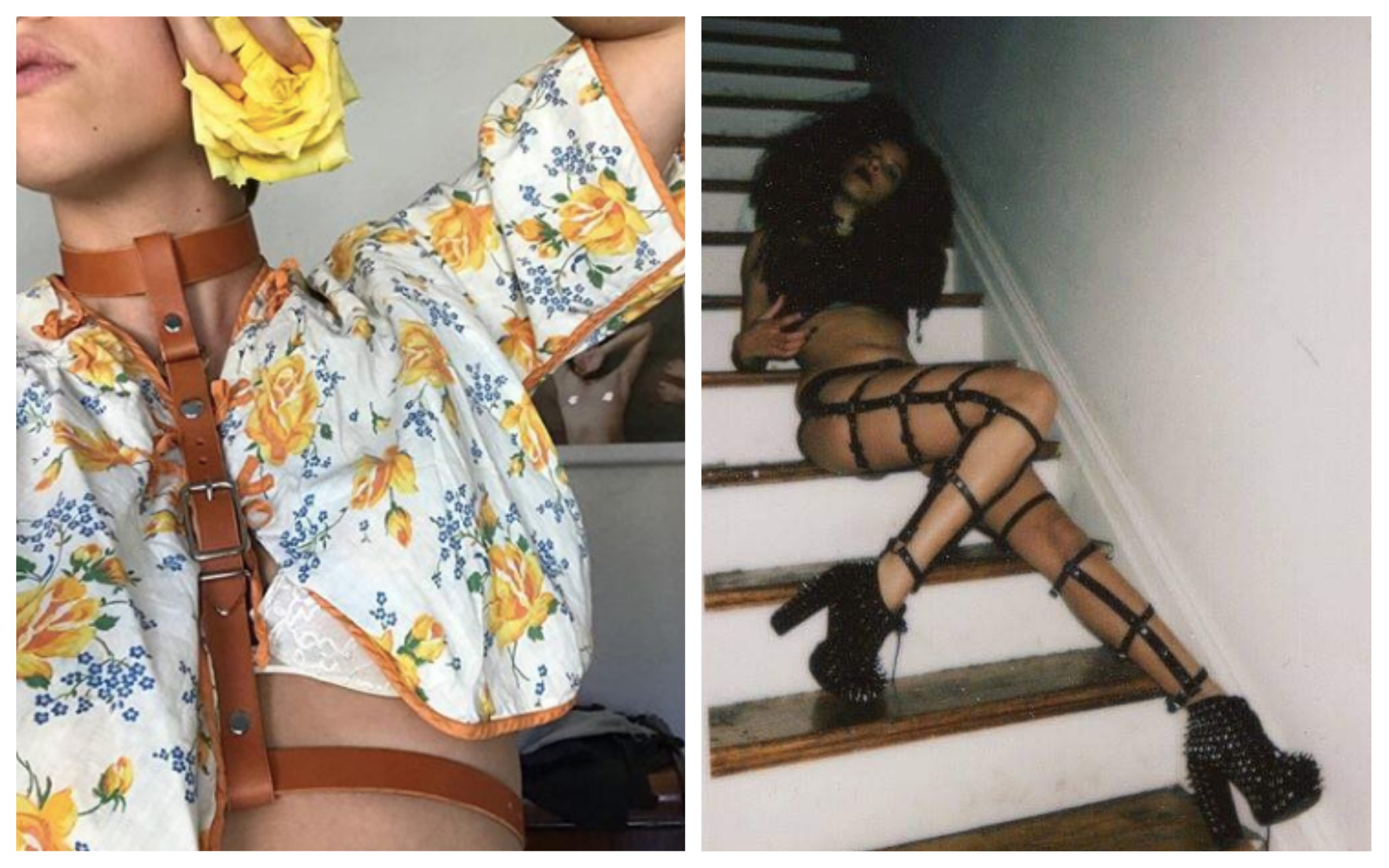Strap-Ons Are Art for This Femme-Friendly DIY Leather Company
Credit to Author: Taylor Hosking| Date: Tue, 14 May 2019 17:07:54 +0000
When I first came across the strap-on and leather fashion company Wild Wolf Leatherwork on its popular Instagram account last year, I couldn’t stop scrolling. It was the first time I saw strap-ons being promoted by anyone other than porn-star-esque white women in intimidating, BDSM-inspired settings. Instead, there were young, femme creatives of all races and body types wearing stunning, high-waisted designs in light, neutral colors. They were holding flowers in airy, well-lit rooms and posing with houseplants (in that timeless Millennial tradition).
The mix of elegant and badass aesthetics drew attention to the fashion potential of strap-ons. Suddenly, an item that has historically made many queer people feel awkward or ashamed, including femme people unsure how it fits in their self-image, had an undeniable beauty to it. That beauty propelled sharing, and brought together a community of nearly 30,000 people to fawn over a toy that’s usually tucked away in the darkest corners of a closet.
As it turns out, the line was started by 25-year-old Ali Esposito, a nonbinary, self-made designer based in a small town called Asheville in the Appalachian mountains of North Carolina. Back in 2014, they were dealing with personal traumas and mental health struggles that left them feeling powerless. As a creative outlet, they started making cuffs and collars from discarded scraps at a local horse saddle shop.
“I found that playing with dominant/submissive dynamics was a way to reclaim my power,” Esposito tells me over the phone from a vacation in Jakarta, Indonesia. Their website says bondage can be “a method of healing, tool for building trust, moving energy, and reclaiming power within ourselves.” But when they decided to make their own strap-on in 2017, they wanted it to take on a different, more elegant approach than what was widely available, which is how their popular high-waisted looks were born.
“Even though I was making some bondage gear, I didn’t want to make a strap-on harness that looked like what I’d seen in a BDSM context, because they reminded me of a really cis heteronormative bondage aesthetic that dominated the imagery I’d been exposed to,” they explained.
Esposito had actually never worn a strap-on before making one, because they found them awkward and intimidating growing up. “I think I was so reluctant before because I was afraid of the style of harnesses I’d seen not representing how I wanted to express myself sexually,” they said. “Designing something for my own body and relationships was such an intimate way to reinvent how a strap-on harness can look and feel, that if I needed it to be glamorous. That’s important, too.”
Through pursuing their vision for curve-accentuating, glam strap-on aesthetics, Esposito found a community of people in their small town of Asheville—and soon, larger online communities—that were eager to buy their work. Now, with 2,300 hand-made Etsy sales under their belt, they’ve turned their hobby into a full-time gig for themselves and their partner Dev, along with a number of part-time helpers.

Without consciously trying to at the time, Esposito became part of a growing movement to reinvent and destigmatize the strap-on. “A lot of strap-on companies didn’t take their customers into account until recently. They were doing hush-hush business because there’s so much shame around it,” says Madeline Nelson-Folkersen, who sells sex toys at Babeland in downtown Manhattan. “Now that there’s less stigma, they can hire actual designers who know what they’re talking about instead of pushing the same crap that’s been pushed since the 50s.”
While older strap-on companies move to upgrade their designs, other, more DIY operations are popping up to fill these important voids because there has still been much less movement on strap-on redesign than for other toys. Shows like Broad City have helped the push to normalize strap-ons, referencing them so many times the show released its own popular strap design with a line of sex toys in 2017. Other companies, like RodeoH and STRAPP, have largely been focusing on making them more ergonomically comfortable for all body types, which sometimes leans toward minimalist styles. But fewer have been honing in on making femme-leaning people feel more attractive in them, which is proving to be a powerful mode of progress.
The idea of making something stereotypically associated with lesbians feel more traditionally feminine might seem puzzling to some. But as Chicago-based designer Gnat Rosa Madrid of the colourful femme-focused strap-on brand GNAT Glitter Kink explains, “People always think the masc butch is the top, and that’s not true at all. There weren’t enough femme options when I started designing back in 2013. Everything was black and utility-looking. When clients put on my gear they say they feel like themselves, that they didn’t know that part of them.”
She wasn’t talking about femme aesthetics for aesthetics’ sake, either. Strap-ons can bring up a lot of anxiety for femmes about what it means to want to wear a penis, and how they can reconcile that with their style and gender expression. Positioning strap-ons as part of a feminine or sophisticated lifestyle aesthetic helps normalize those desires and calm the identity confusion around straps.
Wild Wolf Leatherwork, through (as they say) “harmonizing fashion, functionality, and fetish,” creates images that blend strap-ons into the everyday. It’s a choose-your-own-adventure outside the bedroom, too: Wear one over shorts, or in a more low-key getup like a chest harness with a flowy housedress. “I can see why people would be attracted to the designs. Something that’s used regularly doesn’t always have to be viewed as an extreme kink,” says Emmy Williams, store manager at the lingerie store Narcisse NYC.

“People bond over [Wild Wolf harnesses] in a way that feels reverent,” says Cat Astrovia, one of Esposito’s first loyal customers from Asheville’s queer community. “Lots of people will be like, ‘Oh my God, is that a Wild Wolf harness? I’m saving up to get one.’ And someone else might say they just ordered one, and then everyone’s pulling up their phones, showing what they have saved on Etsy, talking about how hot they’re going to feel when they get it.”
The company is easy to talk about publicly and tends to attract people like Astrovia who aren’t typically into leather strap-ons, or models who wouldn’t typically associate with sex toy modeling. Mariam Bah, a Black woman from Asheville who was drawn to modeling for the company because their work “is just beautiful,” says, “You can tell a lot of love went into it. And when you meet Ali and their partner, wearing it gives you a secure energy that feels and looks a lot better than a random cheap harness.” Esposito shoots each model themselves, creating an intimate environment for all their models, who range from influencers like body positivity activist Ericka Hart and intersex YouTuber Pidgeon Pagonis to everyday people that connect with their work.
Bondage gear has taken the spotlight in recent years in high-fashion arenas like New York Fashion Week and the Met Gala, as well as in street fashion. But the trend has been a double-edged sword, in that people can buy these accessories without knowing the queer history that may have inspired them, and customers take these looks further and further out of context (i.e., when Taylor Swift was dragged for wearing a chest harness backwards as a belt in 2015). Selling sleek interpretations of bondage looks firmly in the context of a strap-on company makes it impossible to lose sight of the queerness reverberating in its designs. “We consciously try to center people who are queer, trans, and non-binary,” Esposito says.
Within this aesthetic push, though, there’s still plenty of focus on creating comfortable, body-inclusive designs. After Esposito came out with their high-waisted design in 2017, their trans femme partner Dev joined the business later that year, and made a harness that places the dildo-holder, or “O-ring,” higher on the pelvis for people who need a little more space. Astrovia also ordered a strap-on with an O-ring on the thigh because, as she puts it, “I was in a space before transitioning [where I was] really wanting to have options that deemphasize my junk.” Now, that design is available for everyone. Other companies are trying to address similar issues, but for Esposito their innovations come from organic interactions. “I’m not the most into studying what other people or companies are up to,” they said. “My interest comes from what my friends are really into. The people I’m aware of are my community.”
Through interrogating their own experience, Esposito got other people thinking about how strap-ons can change to fit their bodies and lifestyles, inspiring others and expanding their community with their vision.
“I never expected this to take off the way it did,” they said. “But now I’m doing this work for my community of queer and trans people. I’m glad I was able to make something for them.”
Sign up for our newsletter to get the best of VICE delivered to your inbox daily.
Follow Taylor Hosking on Twitter and Instagram .
This article originally appeared on VICE US.